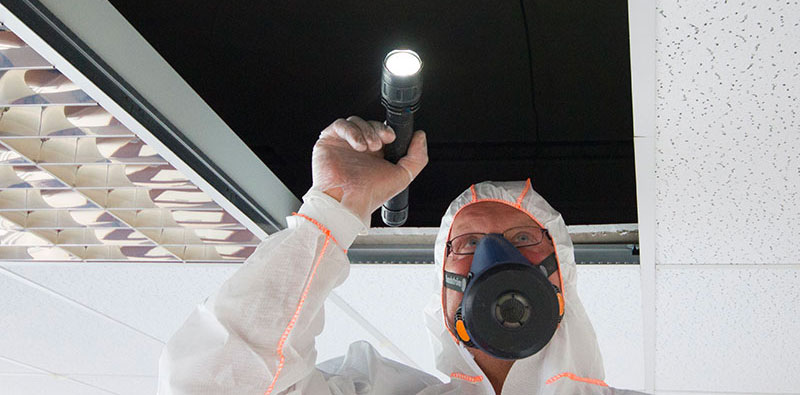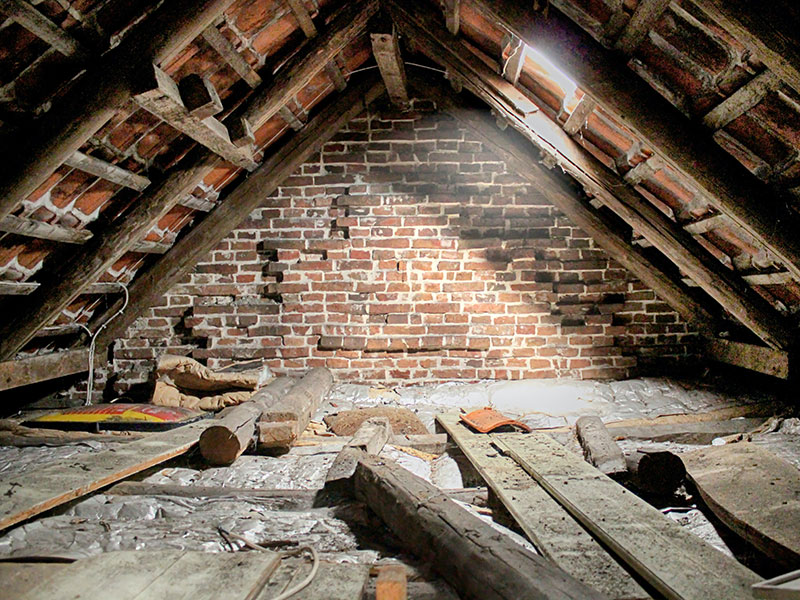What does an asbestos survey involve?
Asbestos surveys are a crucial aspect of ensuring any given non-domestic premises is safe for users and visitors of the relevant buildings.
After all, while this lethal and carcinogenic material was banned in the UK in 1999 – meaning it has not been legally used in the UK construction industry since then – the substance continues to be present in a great number of buildings constructed before the year 2000.
The Control of Asbestos Regulations 2012, or CAR 2012, put in place a “duty to manage” asbestos, directed at people who manage non-domestic premises.
As part of this, the “dutyholder” – the person who manages the given site – is required to take reasonable steps to determine whether asbestos-containing materials (ACMs) are present in the property, as well as other details such as the location, condition, and amount of these materials.
Although asbestos surveys aren’t explicitly referenced in the regulations, they are often essentially mandatory for fulfilling this “duty”. So, what is actually involved in an asbestos survey?
What is the purpose of an asbestos survey?
An asbestos survey is one of the first steps that a dutyholder will need to take in order to safely and legally manage the asbestos that may be present on their site.
You won’t be able to effectively manage any asbestos that might exist on your premises if you don’t even know information like the below, which an asbestos survey will help you to find out:
- The location, amount, and condition of the asbestos-containing materials
- The extent to which the ACMs may have deteriorated or sustained damage
- Whether remedial action will be needed to tackle the asbestos risk
Knowing accurate details about any asbestos that may be present will enable you to take the next steps in the asbestos management process. Those steps will include recording the ACMs, and putting together an asbestos register showing the areas of your premises where asbestos has been discovered to be present.
What type of survey do I need?
Before you will be able to arrange to have an asbestos survey carried out on your site, you will need to know what type of survey you require.
The following are popular types of asbestos survey that you may need to organise for your premises at various times, depending on the circumstances and what you wish to do on your site:
Asbestos management survey
If you don’t yet know whether there is asbestos in your buildings – let alone other aspects like its amount and condition – this is the type of asbestos survey you are likely to request. As its name implies, it is effectively the first step in managing asbestos, with the information that you learn from it enabling you to create an asbestos management plan.
One of the most important things to know about an asbestos management survey is that it is typically non-intrusive in its nature. It doesn’t tend to involve any damage to the building, other the minor damage caused by the process of taking samples.
However, in some circumstances – such as if planned refurbishment works are set to happen soon – a management survey might be more intrusive in relevant parts of the building.
Asbestos refurbishment/demolition survey
Again, the clue to what this type of asbestos survey involves is in its name. Also sometimes referred to as a ‘pre-refurbishment’ or ‘pre-demolition’ survey, this is the kind of asbestos survey carried out when refurbishment or demolition work is scheduled to be undertaken at the premises.
Given that asbestos is particularly dangerous in situations where it is disturbed – which can cause its tiny fibres to be released into the air and subsequently breathed in by someone nearby – you can probably imagine how vital it is to perform such a survey before demolition or refurbishment work is carried out.
This inevitably means a refurbishment or demolition survey is more intrusive than a management survey. This is because the aim is to detect asbestos even in parts of the building where it may be hidden away and easily missed during the premises’ normal day-to-day use.
In fact, such a survey can be extremely intrusive, involving considerable damage to the given building. However, the exact degree of intrusion is likely to depend on the nature of the refurbishment or demolition work planned.
Reinspection survey
Undertaking an asbestos survey on your premises, and determining what asbestos-containing materials are present and their condition, doesn’t mean they will remain in that condition forever. Indeed, if the condition of the on-site ACMs does change over time, this could also mean the need to change aspects of your management plan for the property.
An asbestos reinspection survey helps to account for this risk. As the name suggests, this type of survey entails ‘reinspecting’ the on-site asbestos, looking again at all the positive samples previously found on the premises, and ascertaining whether there has been any change to the ACMs’ condition, as can occur due to accidental damage or even just ‘wear and tear’ in the building.
The surveyor carrying out the reinspection will typically use the information in the initial asbestos management survey to seek out those areas of the premises where the material is present. This will enable them to check the condition of the ACMs, and to report any damage or the need for protection or encapsulation.
What happens during the survey?
As we set out above, the exact things that happen during an asbestos survey will depend largely on the type of survey carried out. However, there are certain stages and processes that are consistently included across the different types of asbestos survey.
When the professional surveyor turns up at your site, they will typically begin with a walk-through of your premises. This will enable them to pick out anything that may be an obstruction to their work, as well as to carry out a general risk assessment of the property, and make sure the surveying processes they intend to use are valid for the site.
Then, they will be able to proceed with the survey in earnest. This will entail them working methodically around the site, identifying materials – drawing upon their own knowledge and experience – that they suspect to contain asbestos.
When it comes to complying with your legal responsibilities to manage asbestos on your site, a consistent principle applies: materials on a given premises must be presumed to contain asbestos, unless there is strong evidence that they do not.
However, it can only be definitively established whether a given suspect material contains asbestos fibres, when a suitable analysis is carried out of a representative sample of the material. So, when you arrange for a professional to undertake an asbestos survey at your site, you can expect them to collect a sample for lab analysis.
Lab analysis is a skilled and specialised task, so you should make sure only suitably trained and competent analysts will perform this work on your samples, in an appropriate analytical laboratory.
An asbestos survey might also involve air testing, if the initial findings of the survey indicate this would be a good decision to help assess the level of asbestos risk.
What happens after the survey? What does an asbestos report contain?
Once the survey has been carried out, you can expect to receive a comprehensive asbestos report. This document should set out all the asbestos materials that the surveyor discovered to be present on your site, in addition to photographs and recommendations on how you can safely manage the ACMs that have been found on the premises.
How to prepare for an asbestos survey
You can make your chosen asbestos surveyor’s work easier by taking the following steps to prepare your site ahead of their arrival:
- Arrange for work areas to be unoccupied when the survey will take place. It might seem almost too obvious a point to mention, but in the areas of your premises that will be surveyed, no one should be present other than the survey team. If it is a refurbishment or demolition survey that you are arranging, there should be no one on the entire premises, unless stringent controls are implemented.
- Make sure you understand the scope of the work to be carried out. As we explained above, different types of asbestos survey can hugely vary in what they involve. So, you should fully inform yourself on what work the surveyor will perform for the requested survey. Upcoming refurbishment or demolition work will require a somewhat different type of survey to a situation where you are simply trying to put together an asbestos management plan for the first time, and don’t intend to make any substantial changes to the premises.
- Ensure the surveyors have full and easy access to the site. Are there any access issues at your premises that could slow down the surveyor’s work, or even require them to come back at a later time to finish the job? If so, you should do everything you can to make sure the surveyor will be able to access and survey the entire site easily and quickly. A classic issue is not having the necessary keys or access code for a given door at the premises – so, make sure that doesn’t happen to you.
How could Oracle Solutions help with your asbestos surveying needs?
You will have hopefully now gained an understanding that it is vital to choose reputable and competent professionals to carry out an asbestos survey on your site. Fortunately, we can give you access to such skilled and certified surveyors here at Oracle Solutions.
Call our team today or complete and submit our straightforward contact form, to obtain a free and great-value quote for an asbestos survey by us.

Written by Brendan Coleman
Brendan Coleman, with decades of experience in the asbestos industry, is a dedicated Quality Manager. Certified as a surveyor and analyst, he is adept in operations and quality management with a keen focus on HSE compliance. His expertise is pivotal in maintaining high safety and efficiency standards. Brendan ensures our UKAS accreditation requirements are consistently met and exceeded, upholding stringent standards in asbestos remediation. His commitment to enhancing quality and customer satisfaction makes him an essential advisor in asbestos management.


